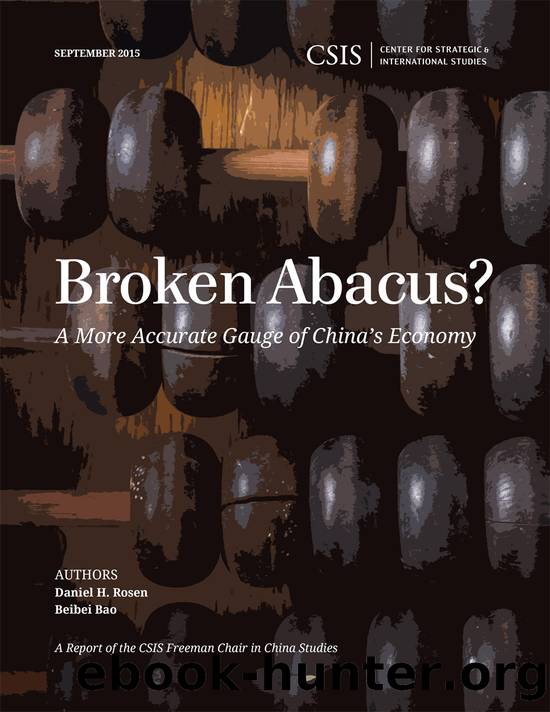Broken Abacus? by Rosen Daniel;Bao Beibei; & Beibei Bao

Author:Rosen, Daniel;Bao, Beibei; & Beibei Bao
Language: eng
Format: epub
ISBN: 9781442240858
Publisher: Center for Strategic & International Studies
Published: 2015-08-19T00:00:00+00:00
A Bottom-Up Approach For the bottom-up approach for service subsectors, we leveraged the same strategy we used for the secondary sector. According to the NBS national accounts manual renewed in 2010, the officially preferred approach to count service VA is the income approach, from which we draw our recalculation formulas, paired with basic data from the Economic Census database:
1. Service value-added = Operating income92 + Current-year depreciation93 + Net taxes on production + Labor remuneration
2. Net taxes on production = Principal business taxes and surcharges + Amount of net taxes on production in operating, administrative, and financial fees94
3. Labor remuneration = Wage and employee benefits payable ÷ Share of that payable to labor Remuneration at administrative accountingâbased entities
Applying this set of formulas to our cleaned-up databases, we were able to compute industry-level VA for all subsectors except education, public administration and social organizations, and finance. Basic data for these subsectors are extremely spotty in the database. When aggregated, the recalculated education VA is RMB 126 billion versus the official claim of RMB 890 billion. This is most likely caused by the evolving nature of Chinaâs education service conditions. Previously, education service providers mainly relied on government grants, but an expanding portion of the subsector is increasingly living on the prices they charge for their services.95 The basic data the Ministry of Education (MOE) is able to collect through its own system is increasingly divorced from actual circumstances. A more reliable reference in this regard is the China Educational Finance Statistics Yearbook (zhongguo jiaoyu jingfei tongji nianjian), jointly compiled by MOE and NBS.96
According to government records, MOEâs financial statistics covered all educational establishments except for those provided by the Party schools, military schools, and Communist Youth League schools.97 Educational services by these entities are categorized as âother unspecified educational servicesâ under Chinaâs industrial classification 2002. Through the 2008 Economic Census Yearbook, we were able to compute the revenue ratio between âother educational servicesâ and the entire educational subsector, which was about 5 percent. It should be noted that the âother education servicesâ in the national industrial classification and the yearbook also include vocational and special education, so we assumed the educational services provided by the military, the Party, and the Youth League accounted for one-third of that 5 percent. With that newly calculated extrapolation ratio, we computed labor remuneration for the entire educational subsectorâbased on the ratio of wage and employee benefits to labor remuneration for educational workers in the 2008 Economic Census Yearbook âand used the relative ratios among the four income-approach components in the 2007 Input Output Tables (operating surplus, fixed asset depreciation, labor remuneration, and net taxes on production) to obtain a 2008 education value-added of RMB 943.7 billion, 6 percent higher than the official figure (Table 3.22).
Download
This site does not store any files on its server. We only index and link to content provided by other sites. Please contact the content providers to delete copyright contents if any and email us, we'll remove relevant links or contents immediately.
The Secret History by Donna Tartt(18743)
The Social Justice Warrior Handbook by Lisa De Pasquale(12080)
Thirteen Reasons Why by Jay Asher(8736)
This Is How You Lose Her by Junot Diaz(6700)
Weapons of Math Destruction by Cathy O'Neil(6084)
Zero to One by Peter Thiel(5637)
Beartown by Fredrik Backman(5545)
The Myth of the Strong Leader by Archie Brown(5374)
The Fire Next Time by James Baldwin(5199)
How Democracies Die by Steven Levitsky & Daniel Ziblatt(5096)
Promise Me, Dad by Joe Biden(5036)
Stone's Rules by Roger Stone(4989)
100 Deadly Skills by Clint Emerson(4798)
A Higher Loyalty: Truth, Lies, and Leadership by James Comey(4796)
Rise and Kill First by Ronen Bergman(4658)
Secrecy World by Jake Bernstein(4593)
The David Icke Guide to the Global Conspiracy (and how to end it) by David Icke(4557)
The Farm by Tom Rob Smith(4404)
The Doomsday Machine by Daniel Ellsberg(4375)
